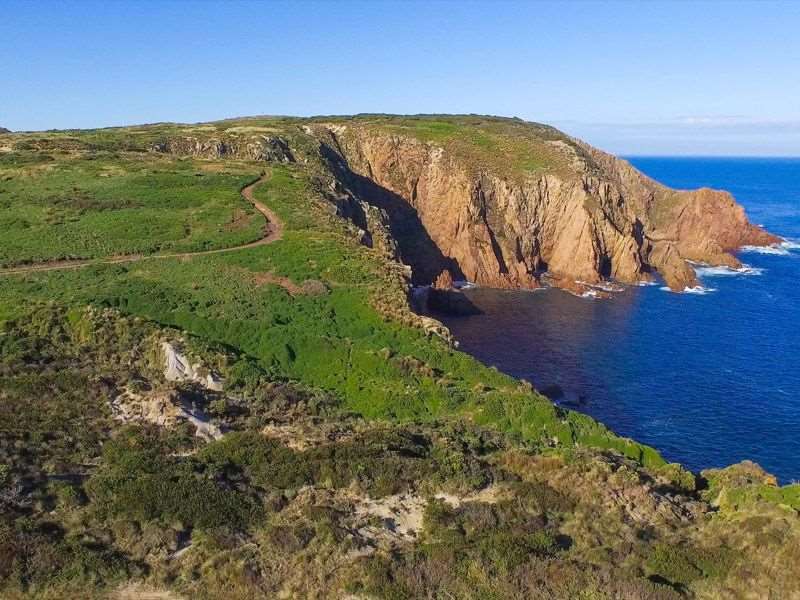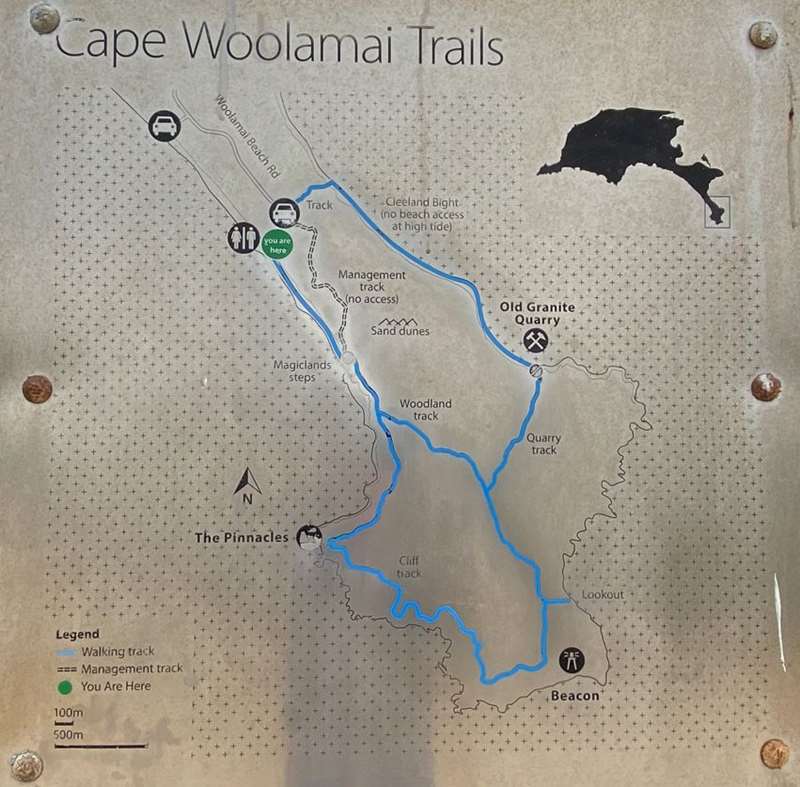Cape Woolamai Walks (Phillip Island)


Cape Woolamai, the highest point on Phillip Island, offers spectacular coastal views and is home for up to a million shearwaters between October and April each year. This area has a range of hikes which breathtaking views and scenery along the route.
Short-tailed shearwaters - World Travellers
Short-tailed shearwaters are also known as mutton birds, moon birds and Biyadin, the local Indigenous word.
Up to 1 million short-tailed shearwaters (Ardenna tenuirostris) have been recorded nesting at Cape Woolamai from late September through until early May. By day they are out at sea feeding on fish, squid and krill. At sunset you can watch the shearwaters' spectacular return as they circle the skies and settle down to their burrows.
Short-tailed shearwaters record amazing distances as they travel around the globe. After spending the northern summer in the oceans around the Aleutian Islands near Alaska, they complete an amazing flight of over 16,000km to locate their partners here and lay a single egg in their burrow.
Short-tailed shearwaters and their eggs were intensely harvested here in the past, reducing the local population. The total population in Australia has declined from an estimated 130 million in the early 1800s to the current estimate of 23 million. Today they are protected on Phillip Island. Please stay on designated pathways to protect their sensitive habitat.
To access the walks, which all start and finish at the Cape Woolamai Beach car park, walk onto the beach, turn left, follow the beach for approximately 1km and take the stairs up to clifftop to loop walks. The track provides stunning views and takes you past the Pinnacles lookout. As you follow the track to the Beacon which is Phillip Island's highest point, there are 360-degree views across Phillip Island, San Remo, Kilcunda and beyond. As the track starts to descend there is a spectacular lookout point, Gull Island Lookout, just right of the track.
Abandoned Quarry
The last loads of pink granite were taken in 1898.
The quarry was established in 1891 for the mining of the unique Cape Woolamai pink granite. To remove the granite, the feather and wedge method was used. Steel wedges were driven into rows of holes drilled into the rock. A jetty was constructed from the granite blocks to enable loading into vessels for shipment to Melbourne as a building material.
In December 1892, the ketch Kermandie disappeared at sea, heavily laden with granite. It is believed the granite shifted in a storm due to inadequate stowage and tipped the vessel over. A block of the Woolamai pink granite can now be viewed at the front of the Council offices in Cowes.
At the quarry site look for abandoned granite blocks showing drill holes for feather and wedges.
The Pinnacles - Ancient Rock
Cape granite is one of the oldest rocks on Phillip Island. About 360 million years ago, molten rock forced its way up from the earth's core. It cooled very slowly beneath the ground, forming the pink granite which is Cape Woolamai's foundation. The granite was expos as the mountains above wore down due to weathering and wave action.
The granite extends down to an unknown depth below sea level. The Pinnacles, as you see now, are the result of cracks which formed as the rock was cooling and shrinking. They have been further sculptured by rain and wave action.
At the Pinnacles look for whales as they pass this vantage point during June and July on their annual migration.
Map of Area

The following walks are available:
- Pinnacles Walk Return - 4.5km / 1.5 hours
- Old Granite Quarry Walk Return - 6km / 2 hours
- Cape Woolamai Beacon Walk Return - 6.6km / 2.5 hours
- Cape Woolamai Beacon Circuit - 8.3km / 3.5 hours
Access for Dogs:
Dogs are not permitted.
Review:
This is a wonderful and spectacular walk, especially when there are large waves crashing on the cliffs. There are a number of interconnected tracks leading from the carpark which go to The Pinnacles, Beacon and Old Granite Quarry ranging from 4.4km to 6.6km return. However, we we definitely recommend doing the 8.3km circuit passing through The Pinnacles, Beacon, Old Granite Quarry and returning along the Cleland Bight beach (not accessible at high tide. Check tides).
There is plenty of wildlife to see along the walk. We saw short-tailed shearwaters gliding above us, two blue-tongue lizards and some swamp wallabies. In February there were plenty of butterflies flitting along the trail with us.
The walks are very well signposted with maps at all the major track intersections (except for the track from Cleland Bight beach to the carpark).
This walk can be very windy and cold irrespective of the time of the year, so make sure that you've got suitable clothing with you.
At the Cape Woolamai Surf Beach there is a large carpark and toilets at the Woolamai Beach SLSC. This beach is patrolled but strong rips make this beach dangerous for swimming. It is best to leave it to the surfers.
-embed01.jpg)
A wooden ramp and stairs leads down to the beach from the car park. Go down to the beach, turn left and walk 1 km along the beach. There's plenty of cuttlefish and interesting things to find washed up on the beach.
Then go up the Magiclands wooden staircase to the top of the cliff. A management track leads back to the carpark from here but access to this track is prohibited.
-embed02.jpg)
You will come to a seat where there is a junction of tracks. You can continue straight ahead to The Pinnacles or alternatively take the left track to the old granite quarry. We continued straight ahead where there are great views from the top of the cliff. The Pinnacles is a spectacular rock formation, especially with waves crashing at the base.
-embed03.jpg)
Continue along the clifftops to the Beacon. On the way there is a cliff with some caves carved out of the cliff.
-embed04.jpg)
Once you reach the Beacon, there are views back to San Remo. A little bit further on there is a lookout point with views over the eastern side of the Cape.
-embed05.jpg)
Both sides of the Cape are quite different. We found the eastern side to be a lot more sheltered.
At the granite quarry, which is located on the beach, explore the rocks looking for signs of quarrying which occurred in the past.
-embed06.jpg)
When we went, it was not high tide, and so we walked along Cleland Bight beach. Unfortunately there were hordes of sand flies so make sure you bring insect repellent with you.
-embed07.jpg)
The sign for the track from Cleland Bight beach back to the carpark was missing. The sandy track leads through the bush just after some sandy cliffs with an area of dead trees on the beach.
-embed08.jpg)
Photos:
Location
288 Woolamai Beach Road, Cape Woolamai 3925 Map
Web Links
→ Cape Woolamai to Beacon Point Loop Walk (Walking Maps)
→ Guide to the Cape Woolamai Circuit Walk on Phillip Island (Beyond Wild Places)
→ Hiking the Cape Woolamai Circuit: Phillip Island
→ Tide Predictions for Victoria











